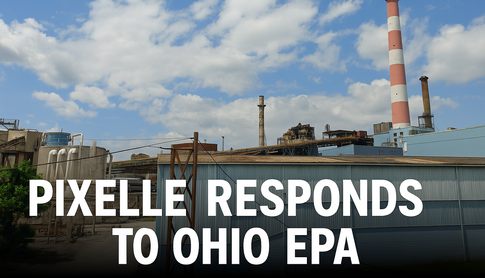
CHILLICOTHE, Ohio – Pixelle Specialty Solutions is responding to a series of inquiries from the Ohio Environmental Protection Agency (Ohio EPA) regarding permit compliance and operational deficiencies at its Chillicothe facility, even as the plant prepares for its impending closure on August 10, 2025. This comes on the heels of the paper mill's recent settlement of a federal lawsuit with the U.S. Environmental Protection Agency (EPA) over a host of Clean Air Act violations, resulting in a significant $234,440 civil penalty.
The Ohio EPA's concerns, distinct from the federal action, center on several areas of state permit compliance, including unfiled reports, monitoring failures, and issues with wastewater treatment systems. As part of the plant's shutdown, Pixelle will also be required to adhere to Ohio's Cessation of Regulated Operations (CRO) rules, which govern the safe and environmentally sound closure of industrial facilities.
Discharge Limit Exceedances and Reporting Lapses
The Ohio EPA noted that Pixelle failed to provide noncompliance reports for two discharge limit exceedances in July 2024: a pH exceedance on July 6, 2024, and a dissolved oxygen (DO) exceedance on July 11, 2024.
For the July 6, 2024, pH event, Pixelle stated that correspondence and a preliminary compliance report were exchanged between company and EPA representatives on August 19, 2024, with additional conversations involving the Ohio Department of Natural Resources (ODNR).
Regarding the July 11, 2024, DO event, an email notification was sent from Pixelle to the Ohio EPA on the same day.
Missing Monitoring Samples and Sludge Reports
The Ohio EPA also flagged that monitoring samples for final outfalls 003, 005, 007, and 009 were not collected in 2024, with the data substitution code “AL” entered for September 2024. Pixelle stated these samples were eventually collected on December 30, 2024, and the data will be submitted.
Furthermore, annual sludge reports for 2022, 2023, and 2024, required under NPDES permit 0IA00002, were not located by the Ohio EPA. Pixelle has since provided copies of these reports.
Stormwater Management and Facility Operations
The Ohio EPA requested a copy of the current Site Stormwater Pollution Prevention Plan (SWPPP) and inspection forms from July 1, 2024, to June 1, 2025. Pixelle is currently verifying the status of routine and quarterly inspections since 2021, noting that while these requirements were temporarily removed, they were reinstated in the 2021 NPDES permit. The company plans to re-initiate these inspections in the third quarter of 2025.
Additionally, submittal records for Pixelle's 2024 annual stormwater report were not identified. Pixelle confirmed that inspections were not conducted in 2024 but stated an annual report for 2024 would be prepared and submitted by August 31, 2025. A comprehensive site evaluation is also scheduled for August 2025.
The last amendment to the Best Management Practices (BMP) plan for spent pulping liquor, soap, and turpentine appears to be from December 18, 2018, with no annual BMP report submitted for 2024. Pixelle stated this report would be prepared and submitted by August 31, 2024, noting that pulping operations have been permanently shut down.
During an inspection, several aerators in the west and east lagoons were observed missing or out of service. Pixelle confirmed no plans to repair or replace aerators in the West Basin, intending to evaluate its conversion into a constructed wetlands treatment system. One aerator in the East Basin is also down, but its operational status is being investigated. The company reiterated that pulp and paper production has ceased.
Questions were also raised about stormwater sample collection points for outfalls 003 and 007, which discharge to Honey Creek. Pixelle explained that samples are collected at catch basins designed to evaluate flows directly from the mill site, avoiding off-site contributions. The company also provided information on identified stormwater outfall 008 and clarified the drainage for the wood prep yard, which routes stormwater to the Wastewater Treatment Plant.
Pixelle addressed the use of the data substitution code "AB" in its September 2024 monitoring parameters, citing communication issues with the laboratory regarding required analyses. The company committed to improving communication protocols.
Finally, Pixelle detailed the methodology for collecting NPDES monitoring samples at station 600, involving a flow-weighted composite sample from acid and alkaline sewers, and listed the various chemical additives used at the Wastewater Treatment Plant. The company re-emphasized that the bleach plant operation has been permanently shut down.
Federal Legal Troubles Preceded Closure Announcement
Just days before Pixelle announced the permanent closure of its Chillicothe paper mill on April 15, 2025 (later updated to August 10, 2025), the company found itself in federal court, settling a civil penalty with the U.S. Environmental Protection Agency (EPA) for multiple violations of the Clean Air Act (CAA).
The administrative action, documented in a Consent Agreement and Final Order (CAFO) with Docket No. CAA-05-2025-0033, addressed a range of alleged non-compliance issues from 2018 to 2022. These included failures to fully enclose and vent its Chemi-washer, adequately treat hazardous air pollutants (HAPs) from pulping condensates, and control HAPs removed during treatment. The EPA also cited Pixelle for failing to operate and maintain affected sources consistent with good air pollution control practices, exceeding carbon monoxide and opacity limits, and failing to continuously monitor emissions. Additionally, Pixelle was fined for failing to repair a visible defect in the Chemi-washer hood vent and for incomplete inspection records. The settlement resulted in a $234,440 civil penalty for Pixelle.
As the plant winds down operations towards its August 10, 2025 closure date, Pixelle must also adhere to Ohio's Cessation of Regulated Operations (CRO) rules. These regulations mandate specific procedures for facilities that handle hazardous or regulated substances to ensure proper removal of chemicals, secure the site, and prevent environmental contamination upon permanent shutdown. This includes actions such as submitting notice of cessation, draining or removing regulated substances from tanks and piping, and posting warning signs.
Add comment
Comments